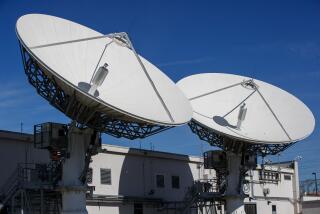The Direct Approach
- Share via
MEXICO CITY — In what is shaping up as Latin America’s biggest media competition ever, two groups of entertainment heavyweights--including Rupert Murdoch, Hughes Electronics Corp. and the continent’s top TV moguls--are about to do battle.
The prize: a direct-to-home satellite TV business that will beam scores of channels into homes from Tijuana to Tierra del Fuego.
We’re talking Big Money. (The main competitors are sinking in about $500 million each.)
Big Players (from Televisa, the world’s largest Spanish-language media company, to Tele-Communications Inc., the No. 1 U.S. cable operator).
And Big Egos (including Murdoch, TCI’s John Malone and Roberto Marinho--so powerful he’s been called Brazil’s “president without term”).
With per-capita income in Latin America averaging less than $4,000, you might wonder why the gold-rush spirit.
But because cable TV barely exists here, entertainment companies smell a success story. They have hungrily watched the rapid growth of direct-to-home, or DTH, in the United States--where nearly 3 million households have signed up in the last two years alone.
“In the States, direct TV was an evolution over the previous technologies in use. In Latin America, it will be a revolution,” said Jose Antonio Rios, the head of Galaxy Latin America, one of the two competing partnerships.
And they won’t start the revolution without Hollywood. Happily for U.S. studios, the two main partnerships facing off in Latin America are promising more than 100 channels each. U.S. distributors could find a new market for everything from Mickey Mouse to Mickey Rourke.
The direct-to-home service differs from cable in beaming programs directly to pizza-pan-size satellite dishes perched on each home.
Reception is often superior to that of cable, thanks to digital transmission. And the companies can offer far more channels.
The potential of the new technology is so great that huge media conglomerates are competing in Asia, Europe and markets worldwide to establish satellite digital TV systems.
Some of the world’s biggest TV names have been drawn to the Latin American arena.
On one side is Galaxy Latin America, a partnership 60% owned by DirecTV International Inc., a Long Beach-based division of Hughes. The California company already runs the fast-growing DirecTV service in the U.S.
That partnership also includes Cisneros Group, a Venezuelan TV giant; MVS Multivision, a scrappy Mexican pay TV company; and Televisao Abril, the pay TV service of Brazil’s huge publisher, Grupo Abril.
*
Galaxy launched its service in Brazil last week with a gala ceremony that drew the president, Fernando Henrique Cardoso. It plans to start up shortly in Venezuela and Mexico, and will arrive in the rest of Latin America by year’s end.
“You find, in our countries, that people really like TV,” said Rios, the company’s chairman, speaking from Galaxy’s headquarters in Fort Lauderdale, Fla. “In my own country, Venezuela, TV has over 99% penetration. That is comparable to anywhere in the world.”
On the other side is Sky Latin America. Holding 30% stakes in the company are Grupo Televisa, run by powerful Mexican TV mogul Emilio Azcarraga; Organizacoes Globo, Brazil’s biggest media company, controlled by Marinho; and Murdoch’s News Corp.
Tele-Communications International Inc., run by Malone, owns the other 10%.
Who will triumph? Stay tuned. Although Galaxy is likely to be at least two months quicker in launching its service, Sky boasts extraordinarily powerful media partners that will promote the new service.
For example, Globo and Televisa each control about 70% of the television audiences in their markets. Eat your hearts out, CBS and ABC.
“Nothing sells television better than television,” said David Evans, president of Fox Television and chief of the coordinating company for Sky Latin America.
What makes Latin America so attractive to the satellite set is its unfriendly geography. With soaring mountain ranges, the Amazon jungle and patches of desert, the region is daunting for anyone who wants to lay cable.
Currently, less than 16% of Latin American households with television receive cable or satellite service, according to Baskerville Communications Corp., a London-based research firm. That compares with about 73% for the U.S.
Sky and Galaxy believe satellite technology will enable them to go where no cable operation has gone before. Still, the companies face hurdles.
The first is cost. Individual satellite dishes and decoder boxes for subscribers will cost upward of $500.
In addition, consumers must pay the monthly charge for programming, which Sky and Galaxy say will be competitive with cable TV prices.
“The problem there is, can consumers afford a $500 dish and decoder system? For many people, that’s a year’s salary,” said Meredith Amdur of Baskerville.
*
The direct-to-home giants say they’ll offer financing packages to help consumers with small pocketbooks.
Both satellite TV groups predict they’ll be able to break even with about 1 million subscribers. Reaching that figure, they say, should be child’s play on a continent with a population of 450 million.
However, some analysts question their optimism.
“They plan to have 3 million subscribers [each] by year-end 2000. It’s going to be more like 2 million each,” said Jimena Urquijo of Kagan World Media, a research and analysis firm in Carmel.
“I don’t know if two teams will survive long-term in the market.”
But both companies are setting their sights well beyond the Rio Grande, planning to eventually beam their service to Latinos in the U.S.
“That could greatly supplement the potential of the business down here,” said Fox’s Evans.
The partnerships will also have to contend with the economic upheavals that periodically wrack Latin America.
For example, Mexico is still suffering from a drastic devaluation of the peso that began in December 1994. It suddenly made U.S. goods twice as expensive in local terms.
Latin American couch potatoes who sign up for satellite TV will receive a mix of programming--international networks such as CNN, Latin American TV shows and special channels created for satellite TV.
For example, Galaxy is planning a Latin American education channel and Sky will offer a Latin sports channel, executives say.
“The programming is basically the [same] one you have in the United States, but it’s tropicalized,” said Miguel Angel Ortiz, a USC graduate who runs Galaxy’s operation in Mexico.
Viewers will be able to switch the program’s language from Spanish to Portuguese to English with the touch of a button.
Satellite TV could create a whole new market for U.S. studios, analysts say.
*
Currently, Latin America has few multiplex cinemas and little pay-per-view television. Royalties from the home video market are small because of widespread pirating of films.
U.S. distributors will gain an additional benefit in being able to bill a few large satellite TV companies.
“You won’t have to go into the wilds of Chile to get those 30 cents per subscriber,” Amdur said.
Although they are the Goliaths of the business, Galaxy and Sky will face competition in Latin America.
Already, two local companies, Medcom and Grupo Acir, have announced plans for direct-to-home service in Mexico.
They will probably offer fewer channels. But the Davids could offer cheap prices, and steal customers from under the giants’ noses.
(BEGIN TEXT OF INFOBOX / INFOGRAPHIC)
Beam Them Up
The big players in the billion-dollar-plus campaign to create a vast direct-TV market in Latin America:
GALAXY LATIN AMERICA
Partners: DirecTV International Inc., a subsidiary of Hughes Electronics Corp. (Los Angeles); the Cisneros Group (Caracas, Venezuela); MVS Multivision (Mexico City); Televisao Abril, the pay TV service of Grupo Abril (Sao Paulo, Brazil)
Investments: More than $600 million
Forecast: More than 1 million subscribers by the end of 1997; 15 million households eventually
Break-even point: About 1 million subscribers
*
SKY LATIN AMERICA
Partners: Organizacoes Globo (Rio de Janeiro); Grupo Televisa (Mexico City); News Corp. Ltd. (Sydney, Australia); Tele-Communications International Inc. (Englewood, Colo.)
Investments: More than $500 million
Forecast: the company would not provide a short-term forecast but predicts 10 million Latin American households will eventually subscribe.
Break-even point: About 1 million subscribers
*
THE GROUNDWORK
As two competing ventures--Sky Latin America and Galaxy Latin America --prepare to beam satellite television across Latin America, they are establishing broadcast centers in seven cities. The broadcast centers uplink TV programs to a satellite, to be beamed to a potential audience of 450 million.
Source: Company reports
More to Read
The biggest entertainment stories
Get our big stories about Hollywood, film, television, music, arts, culture and more right in your inbox as soon as they publish.
You may occasionally receive promotional content from the Los Angeles Times.










